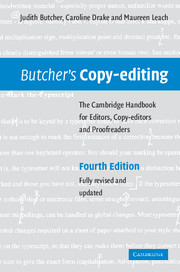Book contents
- Frontmatter
- Contents
- List of illustrations
- Preface to the fourth edition
- Preface to the third edition
- Preface to the second edition
- Preface to the first edition
- Acknowledgements
- 1 Introduction
- 2 Preliminary copy-editing, design and specimen pages
- 3 Preparing the text for the typesetter
- 4 Illustrations
- 5 Proofs
- 6 House style
- 7 Preliminary pages
- 8 Indexes
- 9 Other parts of a book
- 10 Bibliographical references
- 11 Literary material
- 12 Multi-author and multi-volume works
- 13 Science and mathematics books
- 14 Other special subjects
- 15 Reprints and new editions
- 16 On-screen editing
- Appendixes
- Glossary
- Select bibliography and other resources
- Index
8 - Indexes
Published online by Cambridge University Press: 05 August 2012
- Frontmatter
- Contents
- List of illustrations
- Preface to the fourth edition
- Preface to the third edition
- Preface to the second edition
- Preface to the first edition
- Acknowledgements
- 1 Introduction
- 2 Preliminary copy-editing, design and specimen pages
- 3 Preparing the text for the typesetter
- 4 Illustrations
- 5 Proofs
- 6 House style
- 7 Preliminary pages
- 8 Indexes
- 9 Other parts of a book
- 10 Bibliographical references
- 11 Literary material
- 12 Multi-author and multi-volume works
- 13 Science and mathematics books
- 14 Other special subjects
- 15 Reprints and new editions
- 16 On-screen editing
- Appendixes
- Glossary
- Select bibliography and other resources
- Index
Summary
The main purpose of the index is to help readers find their way round the book. Only key concepts and names should be indexed; over-indexing is not helpful and may even put a potential reader off the book.
Most books have a single index, but in more complex books different kinds of information may be separated. An obvious example is a verse anthology, which may have an index of authors, an index of first lines and possibly an index of poem titles. If there is a general index and one or more specialized ones, the general index usually comes last.
The index may be prepared by the author or by a professional indexer. Although the author may well know more about the subject and the needs of the likely readers, a professional indexer will have the benefit of indexing software and experience of working to the publisher's requirements.
Traditionally an indexer works from uncorrected proofs while the author is checking his or her proofs. The index should be given to you for copy-editing at the same time as you receive the corrected proofs from the author and/or proofreader. If you receive the author's or proofreader's corrected proofs before the index is due, look through them straight away, to make sure there are no changes that will affect the index, and particularly changes that will affect the pagination. If you do find any serious changes of this nature, make sure the information is passed on to the indexer.
- Type
- Chapter
- Information
- Butcher's Copy-editingThe Cambridge Handbook for Editors, Copy-editors and Proofreaders, pp. 185 - 206Publisher: Cambridge University PressPrint publication year: 2006



